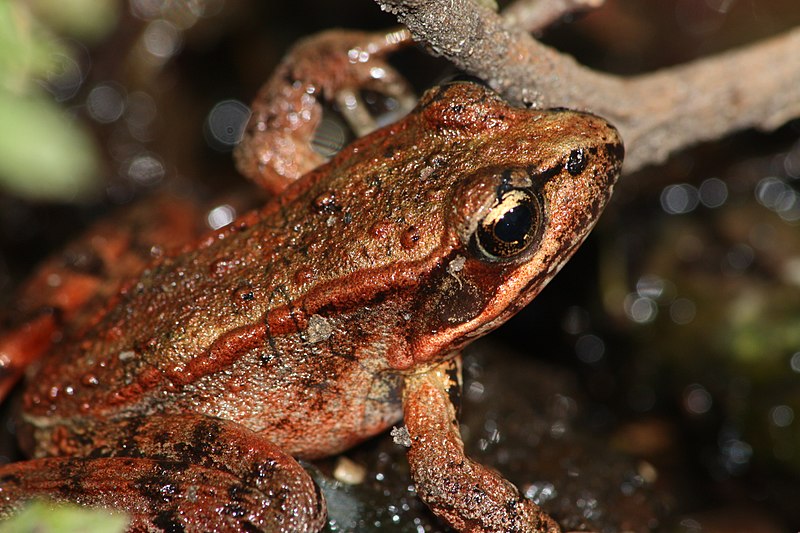Summary of New Species of Frog Found Under a Rock in Venezuela Has Copper Eyes:
A new species of frog with copper eyes has been discovered in Venezuela. The frog, named Stefania lathropae, was found under a rock on the Murisipán-tepui mountain. It is a small frog, measuring slightly over 2 inches long, and has a golden brown hue that can range from plain brown to copper. The species is likely critically endangered due to its narrow distribution range and the effects of climate change. Philippe Kok made the discovery during a four-day animal survey in 2012. The frog was named in honor of Canadian herpetologist Amy Lathrop.
1. Discovery of a new frog species in Venezuela with copper-colored eyes.
2. The frog was found under a rock on a tabletop mountain.
3. The mountain is poorly explored and accessible only by helicopter or technical climbs.
4. The new species of frog has been named Stefania lathropae.
5. The species is critically endangered due to its narrow distribution range and climate change.
In the uncharted depths of Venezuela, a remarkable discovery took place – a new species of frog with striking copper-colored eyes. This extraordinary find occurred when Philippe Kok, an intrepid explorer, embarked on a four-day animal survey of Murisipán-tepui, a mountain shrouded in mystery. With its rugged cliffs and soaring elevation of 8,000 feet, this remote tabletop mountain presented a challenging environment to navigate. However, Kok’s determination was rewarded when he stumbled upon a hidden treasure beneath a solitary stone.
The creature that caught Kok’s attention was unlike anything he had ever seen. It possessed a lumpy body and gazed back at him with eyes ablaze in a brilliant copper hue. Kok’s curiosity was piqued, and he soon realized he had stumbled upon an entirely new frog species.
The Murisipán-tepui mountain, isolated from the outside world, is a landscape that can only be accessed by helicopter or technical climbs. Its peak boasts a unique blend of exposed granite and shrub-like vegetation, while a seasonal lagoon graces its highest point. It was in this unexplored territory that Kok made his astonishing discovery.
During his expedition, Kok unearthed not just one but five of these remarkable creatures concealed beneath rocks near the lagoon and fissures. As he examined them further, he identified them as Stefania lathropae, a new frog species. These tiny frogs grow to just over 2 inches long and possess large, round tongues with a rough texture. Their golden brown coloration ranges from plain brown to shimmering copper.
However, the captivating eyes of the Stefania lathropae frog truly steal the show. One frog displays an orange-brown color that possesses an almost metallic quality. Another exhibits a side pattern tinged with blue, creating a glossy, golden appearance. The third frog boasts a distinctive copper hue with an oily sheen. Each frog is a testament to the diverse beauty found in the natural world.
Interestingly, the Stefania lathropae frog was initially mistaken for another species for nearly two decades. While they may appear similar, genetic analysis reveals an 8.5% disparity. Furthermore, these two species inhabit different mountains with no overlap in their ranges. Their unique skull and subtle physical differences solidify their status as discrete species.
The honor of naming this new frog species falls upon Amy Lathrop, a Canadian herpetologist who, alongside her colleague Ross MacCulloch, meticulously described these newly discovered Stefania frogs gathered in the Pakaraima Mountains of Guyana. Lathrop’s dedication to the study of amphibians has left an indelible mark on the scientific community.
Unfortunately, the Stefania lathropae frog’s dispersion is alarmingly restricted, with its only known habitat being the Murisipán-tepui mountain in eastern Venezuela, approximately 460 miles southeast of the capital, Caracas. This limited range, coupled with the harmful climate change, places this species in gra placer of becoming critically endangered.
The discovery of the Stefania lathropae frog highlights the wonder and mystery within our natural world. It serves as a reminder that there is still much to learn and explore, even in the most remote and unexplored Earth’s corners of the Earth. With each, e gain a deeper understanding of the intricate web of life surrounding us, the importance of preserving these fragile ecosystems becomes ever more apparent.
Nature continues to astound us with its boundless creativity and extraordinary beauty. It is up to us to cherish and protect these remarkable creatures and their habitats, ensuring that future generations can experience the same sense of wonder and awe from uncovering our natural world’s secrets.
In conclusion, the discovery of the Stefania lathropae frog under a rock in Venezuela exemplifies the limitless wonders found in even the most unassuming places. With its mesmerizing copper eyes, this new species is a beautiful reminder of our planet’s wildlife’s intricate and diverse nature. Let us cherish and preserve these precious creatures, an irreplaceable part of our natural heritage.

